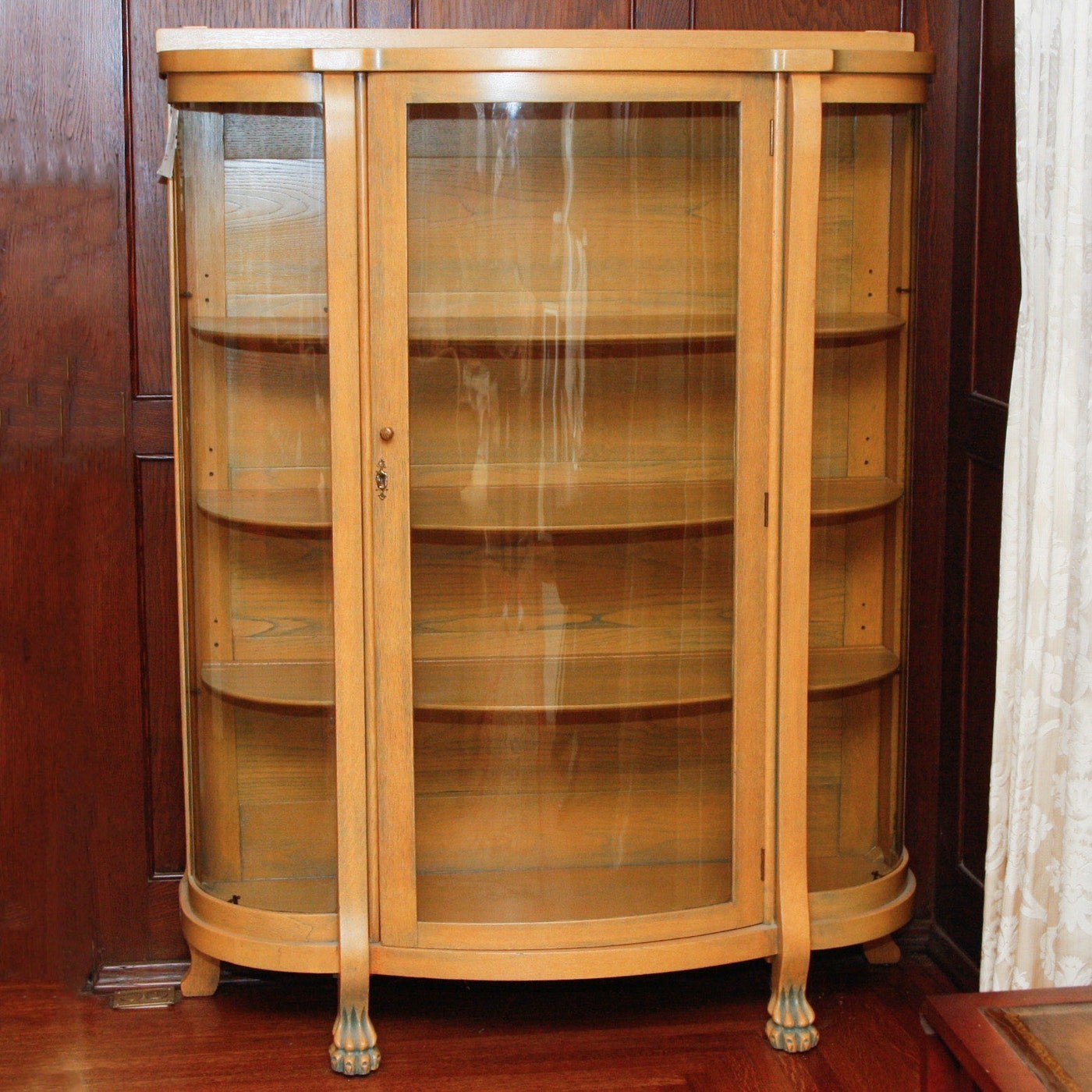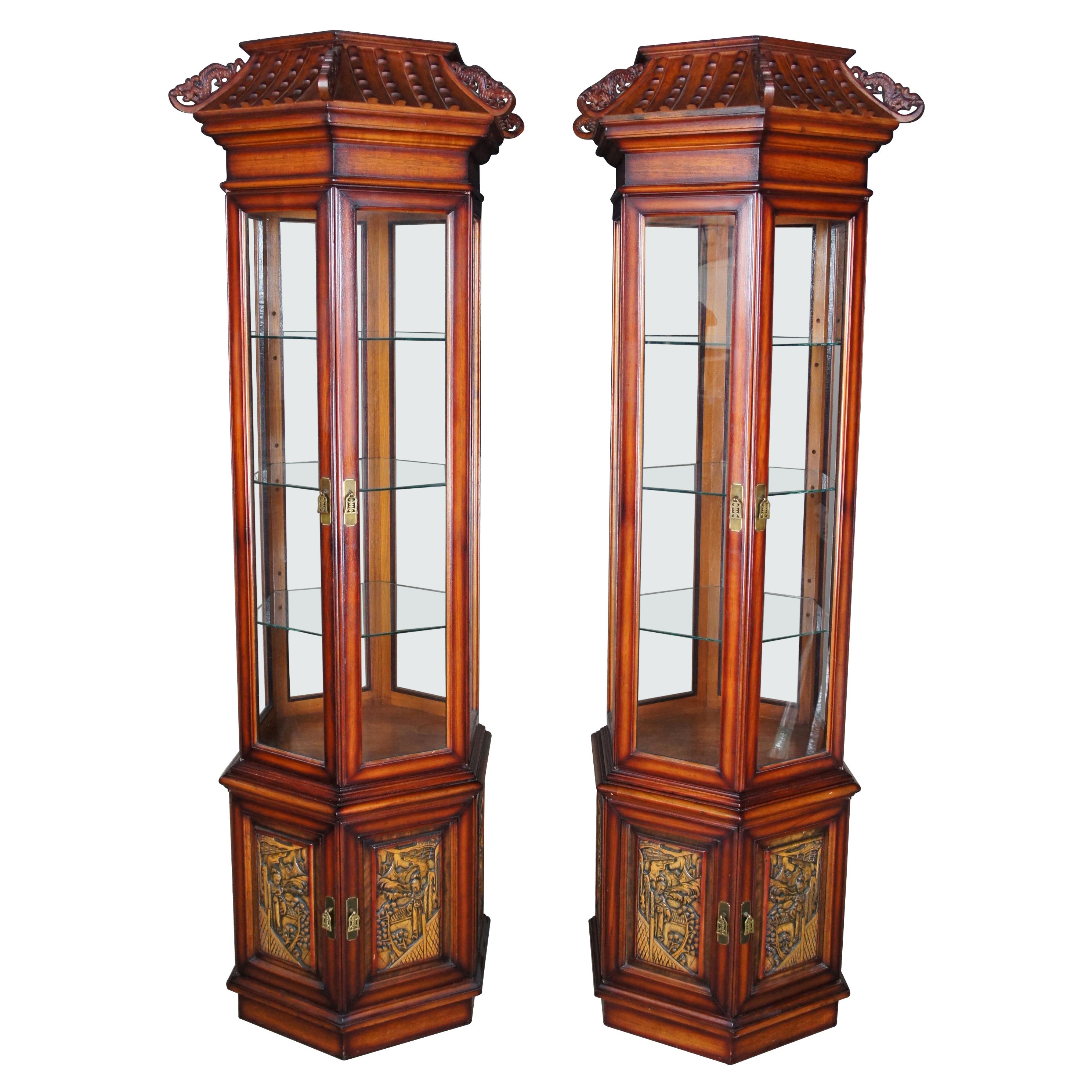Historical Context and Design Evolution of Bow Front Curio Cabinets
The graceful curve of the bow-front curio cabinet, a testament to skilled craftsmanship and evolving aesthetics, reflects centuries of design innovation. From humble beginnings as simple storage units to the elaborate statement pieces we admire today, these cabinets offer a fascinating glimpse into the tastes and technologies of various historical periods. Their evolution mirrors broader shifts in furniture design, reflecting societal changes and artistic movements.
The Rise of the Bow Front: Early Influences and the Georgian Era
The distinctive bow-front design emerged gradually, finding its most prominent expression during the Georgian era (roughly 1714-1837) in Britain. Prior to this, cabinets tended towards more rectilinear forms. The introduction of the bow front, however, signaled a move towards greater elegance and sophistication. Early Georgian examples often featured relatively simple ornamentation, focusing on the graceful curve of the front and the quality of the wood itself, frequently employing mahogany or walnut. The glass, often leaded, was used sparingly, primarily to protect and showcase prized possessions. Craftsmanship emphasized precise joinery and meticulous finishing, techniques honed over generations.
The Victorian Era: Ornate Detail and a Flourishing of Style
The Victorian era (1837-1901) saw a dramatic shift in style. Bow-front curio cabinets became significantly more ornate, reflecting the era’s penchant for elaborate decoration. Darker woods, such as ebony and rosewood, became popular, providing a rich backdrop for intricate carvings, inlays, and veneers. Glass usage increased, with larger panes and sometimes multiple levels of glass doors to maximize display space. The cabinets often incorporated elements of various styles, including Gothic Revival, Rococo Revival, and Eastlake, resulting in a highly eclectic aesthetic. While still demonstrating high craftsmanship, the emphasis shifted somewhat from purely functional joinery to the decorative aspects.
Art Nouveau and Early 20th Century Designs: A Departure from Tradition
The late 19th and early 20th centuries brought about a departure from the heavily ornamented Victorian style. Art Nouveau, with its emphasis on flowing lines and natural forms, influenced the design of bow-front curio cabinets. These pieces often featured less elaborate carving and instead incorporated more subtle curves and decorative elements inspired by nature, such as stylized flowers or leaves. Light-colored woods, such as lighter mahogany or oak, were frequently used, contrasting with the darker woods favored in previous eras. The glass remained prominent, sometimes featuring etched or stained-glass details. While still expertly crafted, the focus moved towards a more streamlined and less cluttered aesthetic.
A Comparative Table of Bow-Front Curio Cabinet Styles
The following table highlights the key differences across four prominent historical styles:
| Style | Approximate Production Dates | Defining Characteristics | Common Wood Types |
|---|---|---|---|
| Georgian | 1714-1837 | Simple ornamentation, emphasis on graceful curve, precise joinery, often mahogany or walnut. | Mahogany, Walnut |
| Regency | 1811-1837 | More elaborate than Georgian, often featuring inlaid veneers and classical motifs, mahogany, rosewood. | Mahogany, Rosewood, Satinwood |
| Victorian | 1837-1901 | Highly ornate, intricate carvings, inlays, and veneers, dark woods, multiple glass panels. | Ebony, Rosewood, Walnut |
| Art Nouveau | 1890-1910 | Flowing lines, natural forms, less elaborate carving, lighter woods, often featuring etched or stained glass. | Light Mahogany, Oak, Cherry |
Materials and Construction Techniques of Antique Bow Front Curio Cabinets

The allure of antique bow-front curio cabinets lies not only in their elegant curves and impressive display capabilities, but also in the meticulous craftsmanship and high-quality materials used in their construction. Understanding these elements is key to appreciating the artistry and enduring value of these pieces. Let’s delve into the specifics of their creation.
Commonly Used Wood Types
The choice of wood significantly impacted the cabinet’s aesthetic and durability. Mahogany, with its rich reddish-brown hue and beautiful grain, was a popular choice, prized for its strength, workability, and resistance to decay. Its lustrous finish enhanced the display of the cabinet’s contents. Walnut, another favorite, offered a darker, more subdued elegance, with a distinctive, often richly figured grain pattern. Cherry, with its warm reddish-brown tones that deepen with age, provided a lighter, more vibrant alternative. These woods, carefully selected for their quality and absence of defects, formed the foundation of these exquisite pieces. Other woods, such as oak and maple, were sometimes employed, particularly in less expensive examples.
Joinery Techniques
The construction of these cabinets showcases a mastery of traditional woodworking techniques. Dovetail joints, known for their strength and intricate beauty, were frequently used to join the cabinet’s case components. Through-dovetails, where the tails and pins interlock completely, provided exceptional strength, while half-blind dovetails, where only the pins are visible on the outside, offered a cleaner, more refined look. Mortise and tenon joints, another stalwart of fine woodworking, were used to connect the legs, rails, and other structural elements. The precision and care evident in these joints speak volumes about the skill of the cabinetmakers. Strong, well-fitted joints were crucial for the cabinet’s longevity and stability.
Types of Glass Used
The glass panes, often framed by delicate moldings, played a crucial role in the overall aesthetic. Early examples often featured hand-blown glass, which often exhibits subtle variations in thickness and texture, adding to its charm. Later cabinets might incorporate machine-made glass, which tended to be more uniform in quality. The type of glass, its clarity, and the way it was incorporated into the frame all contributed to the cabinet’s overall visual appeal. Beveled glass, with its angled edges, could add a touch of elegance and sophistication, reflecting light and enhancing the display of the objects within.
Constructing a Bow-Front Cabinet Door: A Visual Representation
Imagine a simple, elegant bow-front cabinet door. First, a curved template is created, perhaps from flexible wood or a carefully drawn pattern. Two identical pieces of wood, typically mahogany or walnut, are cut slightly oversized according to this template. Using a bandsaw or coping saw, the wood is carefully shaped to match the template, ensuring a smooth, consistent curve. The edges are then meticulously planed and sanded to create a fine finish. The two pieces are then joined together using a variety of techniques. One option is to use a tongue-and-groove joint along the edges, creating a strong, seamless connection. Alternatively, a dado joint could be employed, with a groove cut into one piece and a corresponding tongue on the other. Finally, the door is carefully fitted with glass panes, secured in place with small, decorative moldings. The result is a gracefully curved door, a testament to the cabinetmaker’s skill and attention to detail.
Collecting, Appraising, and Caring for Antique Bow Front Curio Cabinets

Embarking on the journey of collecting antique bow-front curio cabinets is a rewarding experience, blending historical appreciation with the thrill of the hunt. This section will equip you with the knowledge to navigate this fascinating world, from identifying authentic pieces to preserving their beauty for generations to come. Careful attention to detail is key, ensuring you acquire a genuine treasure and maintain its value.
Identifying Genuine Antique Bow-Front Curio Cabinets, Antique bow front curio cabinet
Distinguishing genuine antique bow-front curio cabinets from reproductions requires a keen eye and understanding of construction techniques and stylistic elements. Examine the cabinet’s construction meticulously. Look for hand-crafted details, imperfections indicative of age, and the use of traditional joinery methods. Reproductions often employ mass-production techniques, resulting in a uniformity and precision rarely found in antique pieces. Furthermore, the wood itself offers clues. Authentic antiques will often exhibit signs of age, such as subtle variations in color, minor scratches, and potentially even wormholes (though excessive worm damage diminishes value). The finish should appear aged, not overly perfect or glossy. Pay close attention to the hardware: original antique hardware will often show signs of wear, patina, and age, unlike the often-perfect reproductions. Comparing the piece to known examples from reputable sources, such as museum collections or established antique dealers’ catalogs, can aid in authentication.
Appraising the Value of an Antique Bow-Front Curio Cabinet
Several factors contribute to the appraised value of an antique bow-front curio cabinet. Age is a primary factor, with older pieces generally commanding higher prices. Condition plays a crucial role; a cabinet in excellent condition, free from significant damage or repairs, will fetch a premium. Provenance, or the documented history of ownership, adds considerable value. A cabinet with a verifiable history, perhaps documented through sales records or family inheritance, will be more desirable and valuable. The cabinet’s maker and style also influence its value. Rare or highly sought-after styles, or pieces from renowned cabinetmakers, will command higher prices. For example, a cabinet attributed to a well-known 19th-century maker, accompanied by verifiable provenance, might fetch significantly more than a similar cabinet of unknown origin. Finally, the materials used in construction—rare or highly desirable woods, intricate carvings, or inlaid details—all impact the final valuation. Professional appraisal by a qualified antique furniture appraiser is strongly recommended for accurate valuation.
Cleaning and Maintaining Antique Bow-Front Curio Cabinets
Proper cleaning and maintenance are vital for preserving the beauty and value of your antique curio cabinet. Avoid harsh chemicals and abrasive cleaners that can damage the finish. Regular dusting with a soft, dry cloth is crucial. For more thorough cleaning, use a slightly damp (not wet) cloth, and always test any cleaning solution in an inconspicuous area first. Avoid excessive moisture, as this can damage the wood. Polishing should be done sparingly, using only high-quality furniture polish designed for antique pieces. Never use commercial waxes or polishes that contain silicone.
- Recommended Cleaning Supplies: Soft cloths (microfiber is ideal), distilled water, mild dish soap (optional), high-quality antique furniture polish.
- Cleaning Procedures: Dust regularly with a dry cloth. For deeper cleaning, dampen a cloth with distilled water and gently wipe the surface. If necessary, add a tiny amount of mild dish soap to the water. Rinse with a clean, damp cloth, then dry thoroughly with a soft cloth. Apply furniture polish sparingly, following the manufacturer’s instructions. Never use harsh chemicals, abrasive cleaners, or excessive moisture.
Safely Transporting and Handling Antique Bow-Front Curio Cabinets
Moving an antique curio cabinet requires meticulous care to prevent damage. Proper packing is essential. Begin by carefully wrapping the cabinet in layers of acid-free tissue paper or bubble wrap, paying special attention to vulnerable areas like corners and edges. Use appropriate-sized cardboard boxes or custom-made crates for added protection. Consider using corner protectors and foam padding to further cushion the cabinet during transport. For large or particularly valuable pieces, professional movers specializing in antique furniture transport are recommended. When moving the cabinet yourself, ensure you have sufficient help to avoid dropping or damaging the piece. Always lift the cabinet from the base, using proper lifting techniques to prevent strain or injury. Secure the cabinet in the moving vehicle to prevent shifting or damage during transit. Remember, prevention is key: careful planning and execution minimize the risk of damage during transport.
